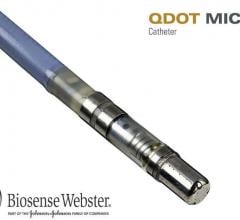February 5, 2019 – The American Society of Echocardiography (ASE) released a new document that provides a comprehensive ...
Stroke survivors have better quality of life three months after their stroke if the clot that caused the stroke was mechanically removed even hours beyond the ideal treatment window compared to those treated with drugs alone. This preliminary research will be presented, Feb. 6-8 in Honolulu at the American Stroke Association’s International Stroke Conference 2019.

The U.S. Food and Drug Administration (FDA) sent a letter to cardiologists this week to explain its evaluation of high ...
Providing exceptional cardiovascular care for patients to achieve the best possible outcomes is the number one goal for ...
In 2018, capital investment in companies developing artificial intelligence (AI)-enabled medical image analysis solutions was almost $580 million. This was more than double the investment into such companies in 2017, according to market research firm Signify Research.
Canon Medical Systems USA recently introduced its next generation of interventional systems – the Alphenix platform. The new flagship platform of systems incorporates all-new features that enable clinicians to deliver images with clarity and precision without compromising workflow and while prioritizing low dose.
Biosense Webster has enrolled and treated the first patient in its U.S. Investigational Device Exemption (IDE) study evaluating the company’s QDot Micro radiofrequency (RF) ablation catheter in the treatment of symptomatic drug-refractory paroxysmal atrial fibrillation (AF). The first AF patient was treated at NYU Langone Health’s Heart Rhythm Center in New York City, one of up to 30 centers participating in the study that will enroll up to 185 patients throughout the U.S.
Cardiac positron emission tomography (PET) is growing in popularity among cardiologists because it provides the ability ...

February 4, 2019 — Stryker announced Feb. 1, the company is launching a voluntary field action on specific units of the ...
Paragonix Technologies Inc. recently received clearance from the U.S. Food and Drug Administration (FDA) for a design enhancement allowing for the use of the Paragonix SherpaPak Cardiac Transport System (CTS) with small and pediatric donor hearts. Starting in Q1 2019, the system will now be shipped with heart connectors covering most aortic diameters, permitting the anchoring of various size hearts including small pediatric hearts to its proprietary suspension system for improved donor heart transport.
A team of Rutgers scientists have taken an important step toward the goal of making diseased hearts heal themselves – a new model that would reduce the need for bypass surgery, heart transplants or artificial pumping devices.
When performing radiofrequency (RF) ablation to treat cardiac arrhythmia, medical professionals must balance the safety ...

February 1, 2019 — Here is the list of the most popular content on the Diagnostic and Interventional Cardiology (DAIC) ...
Merit Medical Systems Inc. announced that the PreludeSync Distal Compression Device is now available in the United States, European, Middle Eastern, African and Asia-Pacific markets. The device is the first specifically designed to achieve hemostasis of the radial artery during procedures where access is gained via the distal radial artery.
Cardiovascular Systems Inc. announced that the first patients in the United States were treated using the OrbusNeich Teleport Microcatheter (Teleport), which recently received U.S. Food and Drug Administration (FDA) 510(k) clearance.
Change Healthcare Cardiology Hemodynamics is an integrated hemodynamic monitoring system for monitoring vital signs and ...
Researchers have mapped the active-state structure of the angiotensin II type 1 receptor, the target of widely prescribed drugs to regulate blood pressure and kidney function. The study, published online Jan. 10 in Cell, was conducted by researchers in the Blavatnik Institute at Harvard Medical School and colleagues at Duke University Medical Center.

The higher expense and lower frame rates of 3-D cardiac ultrasound systems have limited their adoption over the past ...
January 31, 2019 — Nearly half (48 percent, 121.5 million in 2016) of all adults in the United States have some type of ...


 February 05, 2019
February 05, 2019













